Patagonia in 2024
Patagonia in 2024
By Jim Talens, N3JT
Nina and I normally take our overseas trips these days in the form of organized tours to countries with large cities that feature great museums, have fascinating history – and where I know ham radio operators and can meet them astride the tour schedule. But Patagonia, which is essentially the southern part of South America consisting mostly of Argentina but also some of Chile, has little of any of those. It is a relatively desolate kind of place at first glance, with few cities, hardly any notable museums, and few hams. Sure, I have worked stations in Ushuaia (Argentina), El Calafate (Argentina) and Punta Arenas (Chile) over the years, but not in recent months. So why Patagonia? Because it is reportedly filled with great natural beauty and the sorts of sights I could never experience elsewhere. Convincing Nina to go was a minor challenge because the tour description included Zodiac rides, hikes to glaciers and long mountain passes, and 4 days of possibly rough sailing through the fjords and waterways near Cape Horn. I could not understand why this did not attract her! What did convince her were the cool temperatures and her interest in seeing penguins, beautiful mountains, and glaciers. So off we went on January 7, 2024, flying nonstop from Miami to Buenos Aires, where our tour group of 21 would assemble and begin its adventure. I should mention here that a principal reason for preparing this article, apart from sharing our travel experience with others, is to record what we experienced for ourselves.
This trip, organized by Overseas Adventure Travel (OAT) for January 7-21, provided only two evenings free of organized activities, one in Ushuaia and the other in El Calafate, both within Argentina. All other evenings involved scheduled dinners with our 21-person tour group, one dinner with a local family in Ushuaia and the rest aboard our 200-passenger boat that would later take us to Cape Horn, into the Magellan Strait and through part of the Darwin Passage. In the weeks prior to departure, I tried to get in touch with several hams I had worked in these towns but schedules conflicted so we could not arrange any eyeball QSOs, though along the way I did spot two tribanders. More about that later.
Neighbors delivered us midday to a Tri-Rail train station near our home in Boynton Beach. The last stop is the Miami International Airport, which apart from some walking at the airport turned out to be an efficient and cost-effective option over a taxi or Uber. Our 9-hour non-stop flight from Miami to Buenos Aires left at about 8:30 pm. Sleeping on the flight proved elusive. The plane was a Boeing 787 and I think they reduced the seat spacing so that only a small child can find a comfortable position for so long. I guess I must have dozed off because I only got through the first third of Barbi when I awoke with a leg cramp a few hours later.
We arrived at our Marriott hotel in the early morning, too early to access a room and nap so we took a walk along the awakening avenues of downtown Buenos Aires. Adrenalin always fuels energy for the first day of such trips. By 5 pm the other members of our tour group had arrived, leading to the usual introductory meeting where each person notes how many trips they have made with OAT, their own backgrounds, and what they looked forward to seeing in Patagonia. There were 4 physicians in our group, which was unusual, and I was the only attorney (or engineer) among us. We began our acculturation with a tango lesson taught by a professional dancer and bandoneon player. I am not inclined to enjoy dancing, but this was actually rather fun. Soon, though, it was time for us to separate ourselves from our group and meet with Claudia, a museum tourguide we met in Buenos Aires 6 years earlier with whom I remained in contact. A featured cuisine in Buenos Aires is of course their beef, which is very tasty and half or less the cost we would normally pay. To illustrate, we chose a top restaurant in the city and ordered sizeable ribeye steaks, wine, sauteed vegetables, huge salads and dessert, all for about $90 including tip. Claudia could never afford such a meal so we were pleased to liven her culinary experience. I tend to be a mafist (a person who does not eat mammal meat) so this was quite the excursion in cuisine for me.
The next day our group toured Buenos Aires, where I had been twice before, culminating in a dinner at a local family’s home where we discussed Argentine economic and political issues. OAT makes its trips adventures in a variety of ways, including meals with locals. There would be another such meal in Ushuaia. The dinner in Buenos Aires was at a neighborhood apartment and consisted largely of salad, meatballs, and mashed potatoes, with alfajores (a sweet cookie) for dessert, and of course Malbec wine. One cannot help but feel sorry for the people in a country that experienced 200% inflation in 2023 and has a history of horrid dictatorships marked by some 30,000 missing political activists (Desaparecidos), most of whose bodies have not been found. Because of the economy and corruption, massive demonstrations, and the leading generals’ incompetence in the Malvinas (Falklands) war, democracy was restored in 1985. But since then, there has been a succession of ineffectual leaders and a seemingly intractable economy. The recently elected president, Javier Milei, seems to produce a highly polarizing reaction among Argentines. From those we spoke with, mostly better educated people, Milei is a disaster. But the Peronistas did not have answers, either.
The next morning, we boarded our Aerolineas Argentinas flight for a 3-1/2 hour flight from Buenos Aires to Ushuaia, Argentina, the southern-most city in the world located. The city is the largest in Patagonia and sits along the Beagle Channel on the Isla de Tierra del Fuego. See Foto 1.

Foto 1. Ushuaia, the southern-most city on the planet with a population of some 87,000.
This was the beginning of our Patagonian adventure. We posed for photos in the dock area before a huge “Ushuaia” block structure, and later walked along the nearby Beagle Channel shore that consists of rounded, glacially-worn stones. A local guide provided us with more details about the Malvinas war, how ill-prepared the Argentine navy was, and the underlying reasons for starting the war (yes, for the generals in power to distract public attention from the Desaparecidos and the economy!). Some 600 Argentine soldiers died (and 255 Brits). Argentina remains less than pleased that Chile sided with Britain over this one, partly because Chile feared a possible Argentine attack for other reasons. Both Argentina and Britain have arguments for sovereignty over the Falklands but the British have been on the islands for the last 200 years. During the guide’s discussion we got our first taste of the strong winds that would characterize much of our Patagonia visit. Interestingly, the temperatures in summer do not go much below the mid 40’s (5C), and in winter rarely below 25 degrees (-3C), but the wind is worst during summer. We were then on our own until dinner so we visited the Maritime Museum, Prison Museum, Museum of Art, and 2 preserved early homes. The Maritime Museum had excellent displays of Patagonian birds and animals, dioramas of native cultures and history of the region, including stories about sea adventures like those of Shackleton. The Prison Museum was partially converted to art booths for sales and display. Some booths featured descriptions of notorious inmates with colorful histories.
That evening we had our second local-family dinner, this one offered by a couple long resident in Ushuaia. Their home was quite lovely, with multiple rooms and great views. But this was just the warmup because Ushuaia was the embarkation point of our Ventus Australis boat trip of four days, taking us to glaciers and waterways most of us had only read about in featured adventure stories and in our tour catalog.
We were delayed in departing the port at Ushuaia by several hours due to high winds that made docking the incoming Ventus Australis vessel risky. We all walked together to a restaurant about a mile away and had a nice dinner. It is interesting that I cannot remember hardly any of the meals of our trip with greater specificity than that they were good. I always chose fish or chicken, sometimes pasta, but regret to admit that I always ate the invariably very tasty desserts. Later I will describe the one dessert I clearly remember, and why. By the time our dinner was finished the Venus Australis had docked and we boarded. During the evening we sailed eastward in the Beagle Canal and then south through Murray Channel, and Nassau Bay toward Cape Horn, the southernmost point of South America, where so many ships were lost over the centuries. See Foto 2. It is very rough water because of the convergence of the Atlantic and Pacific oceans and the winds that are funneled by the Andes. We were fortunate that the weather was not bad, but it was bad enough to prevent us in the morning from boarding the Zodiacs (rigid inflatable boat used to transport people from cruise ships to land) and standing on Cape Horn. I remember trying to walk down the hallway of the ship and essentially bouncing from wall to wall with the waves. Fortunately, Nina and I had Scopolamine patches and so were never seasick, which we most assuredly would have been. See Foto 4 (lighthouse at Cape Horn).

Foto 2. Display in the ship’s quarterdeck showing our path aboard ship from Ushuaia (Argentina) to Punta Arenas (Chile).
Heading north again, we stopped at Wulaia Bay, where Charles Darwin stopped during his voyage with the Beagle. It is a stunningly beautiful area, lush with great views. The next day we took Zodiacs to two glaciers, Pia and Porter. There were 10 or 14 people aboard each Zodiac, and we approached quite close to the glaciers, different in their positioning in the mountains and the way they calved. Some glaciers are solely on dry land and so ice falls off them into the water; others are longer and extend into the sea, calving both from underneath and above. See Fotos 5, 6 and 7. We also visited the Condor Glacier, where we saw many condors. See Foto 8.

Foto 3. View of Wulaia Bay, and the Ventus Australis.
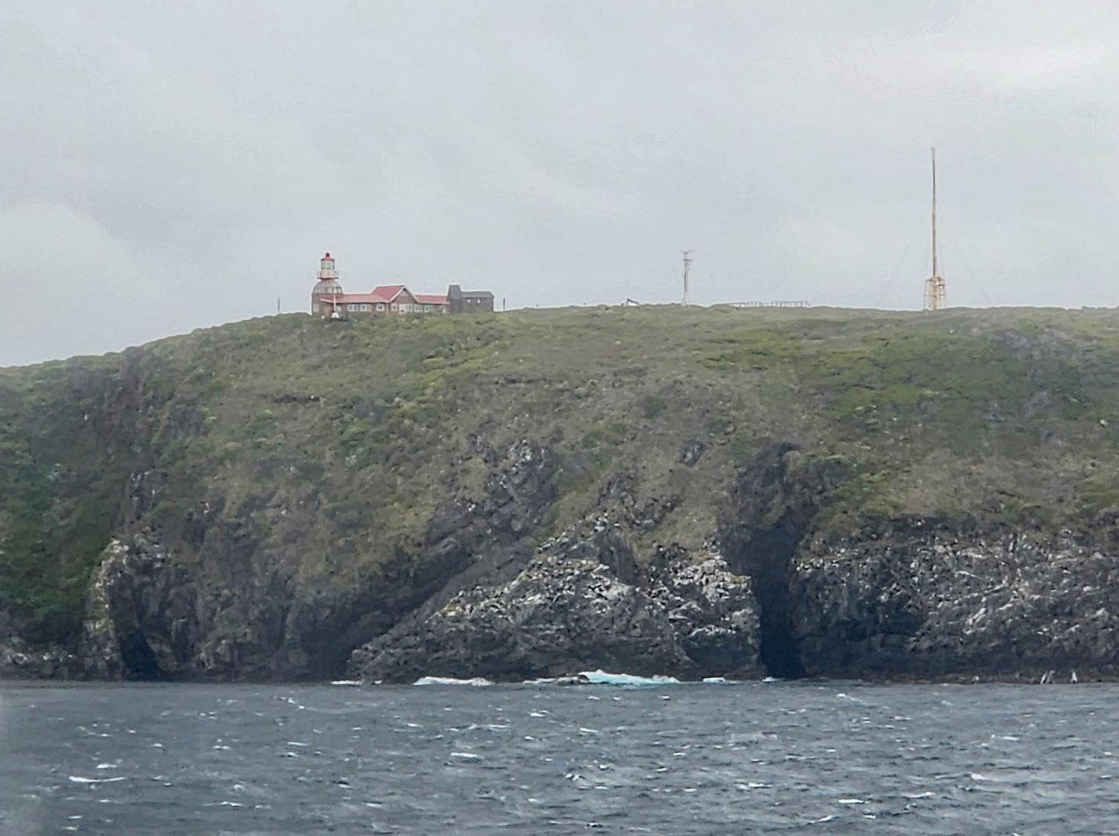
Foto 4. Cape Horn lighthouse from our ship.
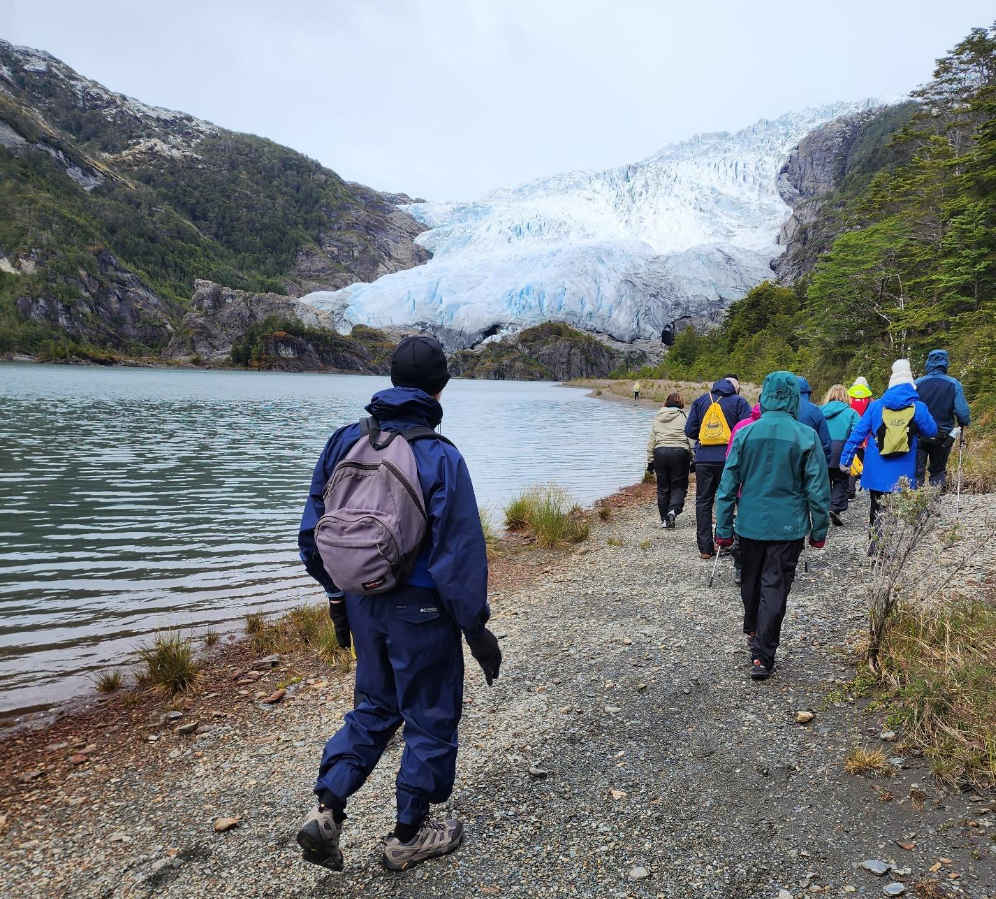
Foto 5. Walking towards Pia Glacier.

Foto 6. A typical view to the majestic Atlas Mountains (not the Andes).
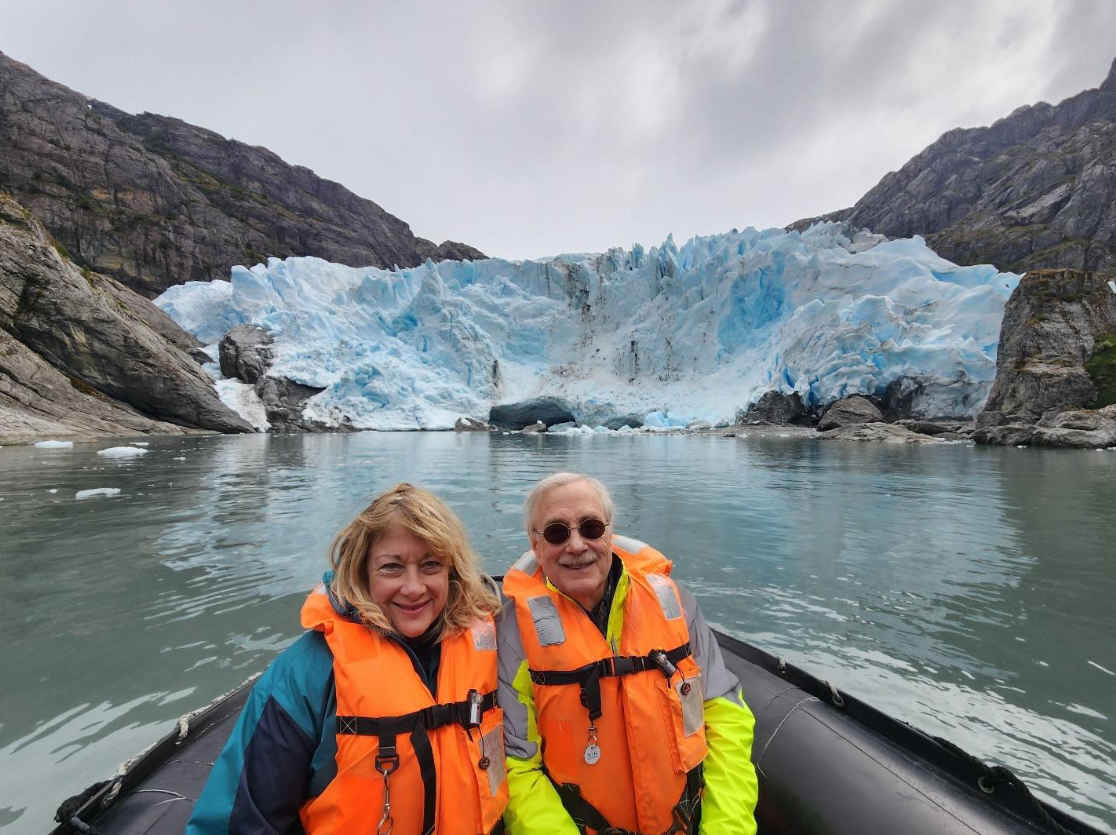
Foto 7. Nina and Jim in front of a glacier. Either Pia or Porter, I cannot remember!!
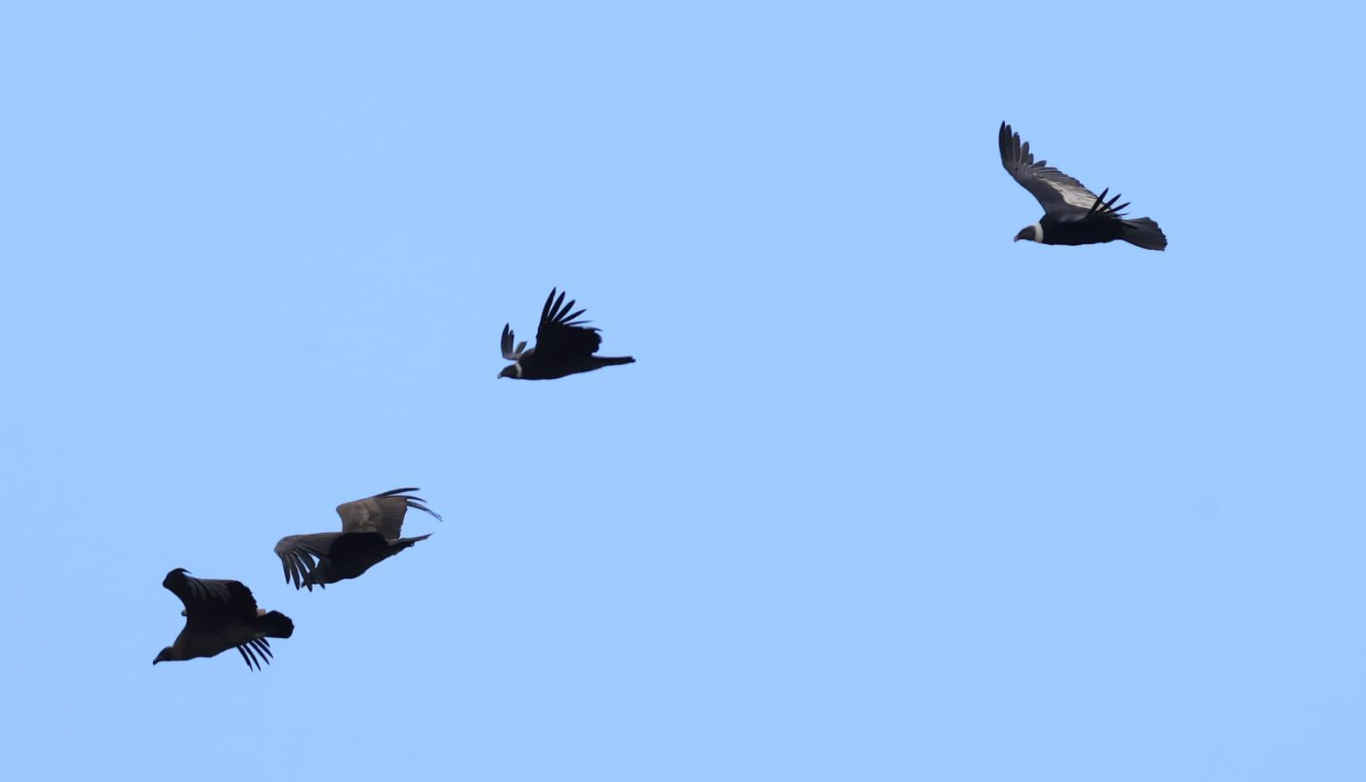
Foto 8. Andean condors.
We made several additional stops at glaciers and overlooks, but of great interest was the stop on Magdelena Island in the Magellan Strait to see the Magellanic penguins. They are clearly not afraid of people and in fact will walk up and presumably challenge you as you get too close to their nests, though the path we had to follow is many feet away from the nests. There is no vegetation so they dig shallow burrows. See Fotos 9 and 10. Note that the penguins taste like chicken. (Just kidding; making sure you are reading everything!)

Foto 9. Magellanic penguin on Magdalena Island, in the Magellan Strait.

Foto 10. A penguin pileup.
Our next stop in the Magellan strait was Punta Arenas, a city in Chile of about 125,000 people. It was the demarcation point of our sea voyage and the beginning of the final land portion of our tour, which would include visits to Torres del Paine National Park, Porto Natales, and El Calafate. Punta Arenas has a lovely, multiple-vessel outdoor museum (Museo Nao Victoria) featuring recreations of the Beagle (Darwin’s ship), the Chilean Schooner Ancud that claimed the tortuous Strait of Magellan for Chile, and a replica of the lifeboat that saved Ernest Shackleton’s team. See Foto 11.

Foto 11. Replica of Ferdinand Magellan’s Nao Victoria.
We left Punta Arenas and headed by bus north to Porto Natales, which borders Torres del Paine National Park, at its center the Cordillera del Paine, the series of tall mountains that give such majesty to the rivers, lakes, and overall landscape of this area. The park is a transition area between the Magellanic subpolar forests and the Patagonia Steppes. Our hotel was essentially a spa with a lovely indoor pool and fantastic views of the mountains. We hiked for about 90 minutes and saw a variety of wildlife, including condors, guanacos (cousins to llamas), rheas, crested caracara birds, and gray fox. See Foto 12. The Paine Massif consists of granite mountains that emerge suddenly from the Patagonia steppes and are capped by crumbling sedimentary rock. They are only some 12 million years old. The sedimentary rock and magma collided violently through tectonic motion and were thrust upwards, later worn to the current striking pattern by Ice Age melting.
One thing we missed here (and elsewhere on the trip, actually) was a view of the southern sky at night. Most of the Milky Way is visible only from the Southern Hemisphere and I had looked forward to seeing that sky, but we were either too tired to stay up so late (remember, there are only a few hours of darkness at night that far south in summer) or there was cloud cover. We also visited a sheep farm, ate lamb chops, and watched shearing. Warming temperatures have led to reduced grass for sheep so that the future of sheep farming is at great risk in Patagonia. We stopped at Lago Pehoé, a beautiful place adjacent to a mountain river cascade. It is notoriously windy in that area and our visit was no exception. In fact, they closed the path to the overlook as we exited because winds were more than 60 mph. Several people had to crawl to safety, and one of our group (notably the tallest among us) fell, cutting his face in several places. Our final stop was El Calafate on the northern edge of Patagonia. The area is named for the indigenous Calafate bush, which is a small, tart berry that produces the best dessert I think I have ever had. It was so good I dedicated a photo to it! See Foto 13. It is much like tartufo, the Italian dessert that consists of a round scoop of vanilla ice-cream with a maraschino cherry in the middle, all covered with dark chocolate. This Patagonian killer-dessert is a step up from tartufo. It is made from calafate ice cream (with berries in it) covered by dark chocolate. It is not available in Buenos Aires or anywhere else outside Patagonia. The route to El Calafate required us to change buses at the Chilean-Argentine border. We were now in Argentina again.
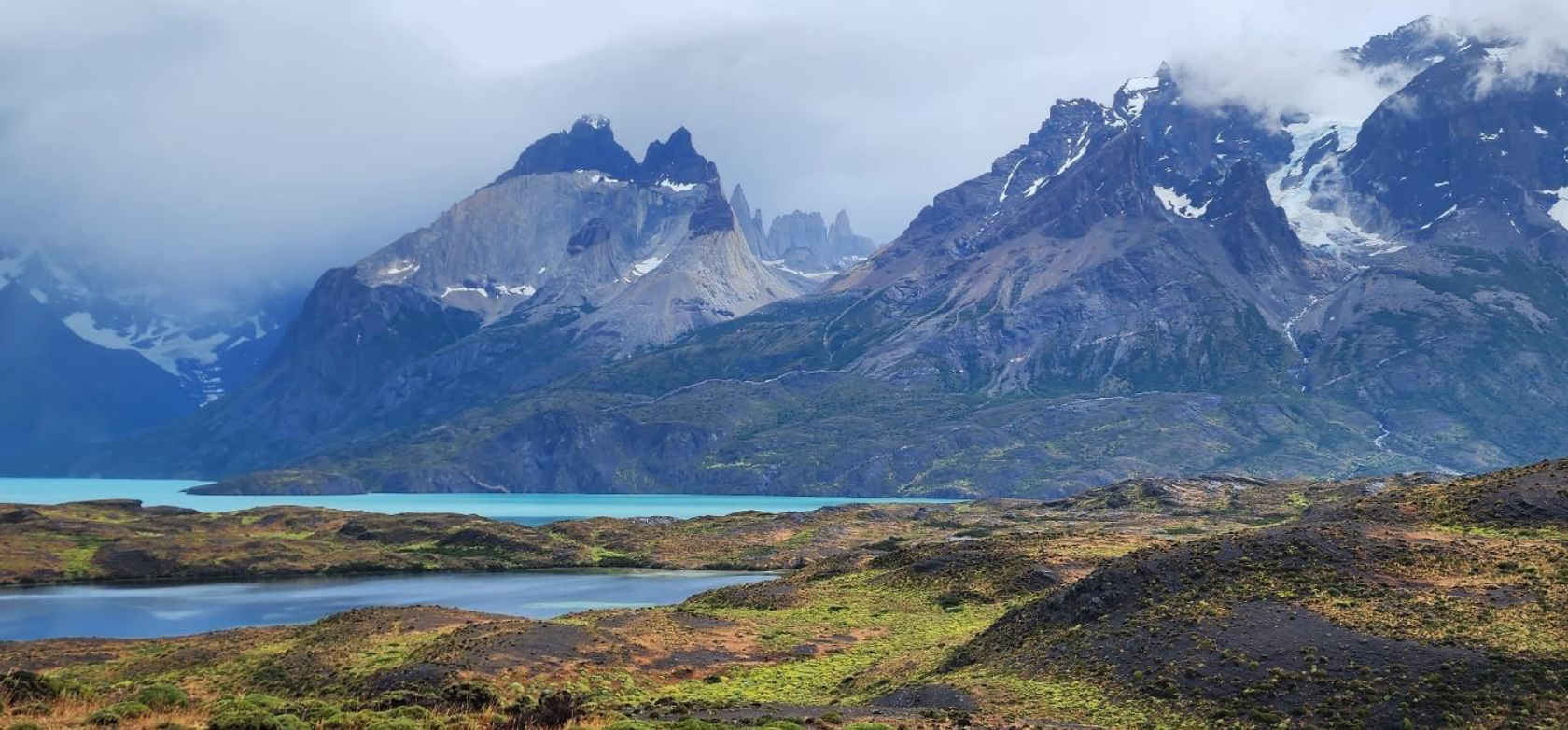
Foto 12. Torres del Paine Massif. A massif is a compact group of mountains.
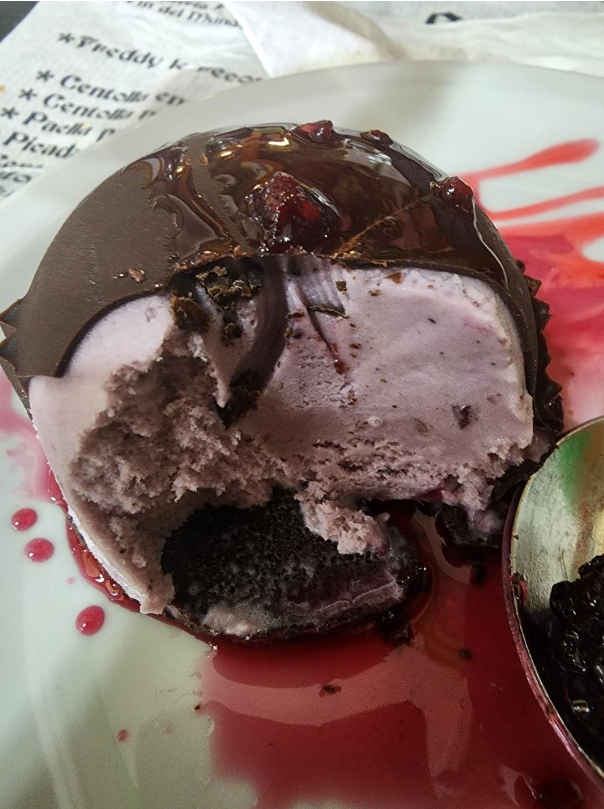
Foto 13. Calafate ice cream made from calafate berries (Magellan barberry, or berberis microphylla). I have a photo of the dessert untouched, but this gives you a better view!
We went by bus a few miles west of El Calafate in the Los Glaciares National Park to see the Perito Moreno Glacier, a pristine site some 200 feet above Lake Argentino. It was named after Francisco Moreno, a 19th-c Argentine explorer who played a role in resolving a border dispute between Argentina and Chile in this area. We watched calving (no, not the birth of cows!): large sections of ice falling into the sea; and we were able to walk along catwalks to see the glacier from different heights and angles. It was quite impressive. See Foto 14. We also took a horseback ride in the scenic area of our hotel. I even succeeded in picking a few calafate berries along the way from atop the horse. The woman riding the horse behind mine kept yelling at her horse to stop putting its nose up my horse’s butt, but her horse apparently was not fluent in English.

Foto 14. Perito Moreno Glacier.
The next day we headed to the airport and flew back to Buenos Aires. Several of us had luggage that weighed more than the 33-lb. limit for flights within Argentina, but our tour company paid the overage (which turned out be about $7 per person). The limit internationally is higher so that was no problem, of course. Include a few souvenir rocks from Patagonia and you can increase the weight of your suitcase easily! I am told they frown on smuggling Magellanic penguins into the luggage.
We had one final day in Buenos Aires. Our tour included an excursion by boat in Tigre, part of the Paraná Delta adjacent to Buenos Aires. There are dozens of interconnected waterways featuring vacation homes and secluded residences accessible only by boat. We had no notion of this aspect of life in Argentina so close to Buenos Aires. Nina and I enjoyed a final steak dinner and headed to the airport for our overnight flight home.
Now a word about ham radio during the trip: I saw two triband antennas, one in El Calafate and the other in Ushuaia, but no meetings ensued. We walked from our hotel to the house in Ushuaia where earlier I had seen a tower and beam from our bus, but nobody was home. The ham’s next- door neighbor greeted us and told us the ham was out, which I could tell because his car was gone! I left my card on the front door with my email address but never heard from him. The neighbor further noted that the ham’s wife just passed away and he was perhaps visiting his family. Between Google Maps and my walk, I think I found his call sign. The other antenna, in El Calafate, was on a street I recorded, but no El Calafate ham on QRZ.COM is listed with that street name. Nevertheless, a ham in El Calafate who was away at the time of our visit later told me his call sign. So it goes.
Unfortunately, one of our group tested positive for Covid at the beginning of the trip. He wore an N-95 mask and ate at a separate table. We still were in close quarters in the bus and when walking, however. By the end of the first week there were 4 members similarly situated, some with no symptoms but testing positive, others coughing. By the end of the trip at least half were coughing, though Nina and I seemed to have it the worst (despite having all the inoculations plus RSV and flu shots). We wore our N-95 masks but at the Buenos Aires airport several people moved away from us in reaction to our prolonged coughing outbursts. We took what medications we could and survived the flight to Miami, where we walked to the Tri-Rail train, rode to our local station, and took an Uber home. We have since fully recovered.
This trip was excellent, far more fascinating and fulfilling than we had anticipated. Part of that is due to the excellent program and tour-guides of the company we chose, but underlying it all is the land itself, filled with wildlife, desolation, beauty, glaciers, wind, and history. It is the “other part of the world” most people might never see, but should. Even if ham radio is not part of it!
For some fotos of the trip: https://photos.app.goo.gl/5qDjHmVVN9zwn9p87
February 1, 2024
Source: N3JT open_in_new
Submit a Story
Do you have a story to share with the ham radio community? We want to feature your amateur radio related story, event, project, or anything else related to the world of ham radio.
Headlines
on HamClock
View the latest news from Amateur Radio Daily on HamClock, a beautiful presentation of information pertinant to the radio amateur.